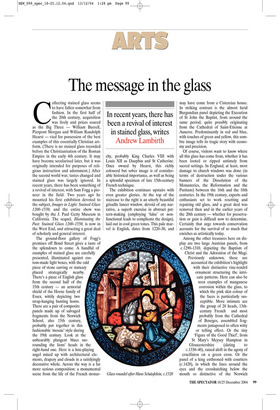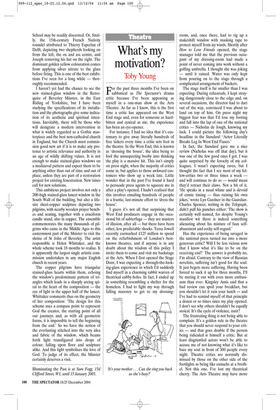The message in the glass
In recent years, there has been a revival of interest in stained glass, writes Andrew Lambirth
Collecting stained glass seems to have fallen somewhat from fashion. In the first half of the 20th century, acquisition was lively and prices soared as the Big Three — William Burrell, Pierpont Morgan and William Randolph Hearst — vied for possession of the best examples of this essentially Christian artform. (There is no stained glass recorded before the Christianisation of the Roman Empire in the early 4th century. It may have become secularised later, but it was originally intended for purposes of religious instruction and adornment.) After the second world war, tastes changed and stained glass was largely ignored. In recent years, there has been something of a revival of interest, with Sam Fogg a pioneer in the field. Two years ago he mounted his first exhibition devoted to the subject, Images in Light: Stained Glass 1200–1550, and the entire show was bought by the J. Paul Getty Museum in California. The sequel, Illuminating the Past: Stained Glass 1200–1550, is now in the West End, and attracting a great deal of scholarly and general interest.
The ground-floor gallery of Fogg’s premises off Bond Street gives a taste of the splendours to come. A handful of examples of stained glass are carefully presented, illuminated against custom-made light boxes, with the odd piece of stone carving or statuary placed strategically nearby.
There’s a piece of English glass from the second half of the 15th century — an armorial shield of the Horne family of Essex, wittily depicting two strap-hanging hunting horns. There are a pair of composite panels made up of salvaged fragments from the Norwich School, also 15th century, probably put together in this fashionable ‘mosaic’ style during the 19th century. Look at the unbearably plangent blues surrounding the lions’ heads in the right-hand one. Here is a lute-playing angel mixed up with architectural elements, drapery and clouds in a satisfyingly decorative whole. Across the way is a far more serious composition: a monumental scene from the life of the French monar chy, probably King Charles VIII with Louis XII as Dauphin and St Catherine. Once owned by Hearst, this richly coloured but sober image is of considerable historical importance, as well as being a splendid specimen of late 15th-century French technique.
The exhibition continues upstairs with even greater glories. At the top of the staircase to the right is an utterly beautiful grisaille lancet window, devoid of any narrative, a superb exercise in abstract pattern-making (employing ‘false’ or nonfunctional leads to complicate the design), laid out in cool green tones. This pale marvel is English, dates from 1220–30, and may have come from a Cistercian house. In striking contrast is the almost lurid Burgundian panel depicting the Execution of St John the Baptist, from around the same period, quite possibly originating from the Cathedral of Saint-Etienne at Auxerre. Predominantly in red and blue, with touches of green and yellow, this sombre image tells its tragic story with economy and precision.
Of course, visitors want to know where all this glass has come from, whether it has been looted or ripped untimely from sacred settings. In England, at least, most damage to church windows was done (in terms of destruction under the various banners of the Dissolution of the Monasteries, the Reformation and the Puritans) between the 16th and the 18th centuries. In the 19th century, experts and enthusiasts set to work resetting and repairing old glass, and a great deal was removed then and in the earlier years of the 20th century — whether for preservation or gain is difficult now to determine. Certainly that urge towards conservation accounts for the survival of so much that enriches us artistically today.
Among the other treasures here on display are two large Austrian panels, from c.1290–1310, depicting the Baptism of Christ and the Adoration of the Magi. Previously unknown, these are accounted the exhibition’s highlight with their distinctive vine-tendril ornament structuring the intricate patterns. Here can also be seen examples of manganese corrosion within the glass, to which the pink skin colour of the faces is particularly susceptible. More intimate are the group of 28 heads, 13thcentury French and most probably from the Cathedral of Bourges, assembled fragments juxtaposed to often witty or telling effect. Or the tiny ‘Figure of the Good Thief’, from St Mary’s Meysey Hampton in Gloucestershire (dating to c.1330–40), raised aloft in the agony of crucifixion on a green cross. Or the panel of a king enthroned with courtiers (c.1420), in which the lines around the eyes and the crosshatching below the mouth so distinctive of the Norwich School may be readily discerned. Or, finally, the 15th-century French Nativity roundel attributed to Thierry Esperlan of Delft, depicting two shepherds looking on from the left, the ox and ass centre, and Joseph removing his hat on the right. The dominant golden yellow colouration comes from applying silver nitrate to the glass before firing. This is one of the best exhibitions I’ve seen for a long while — thoroughly recommended.
I haven’t yet had the chance to see the new stained-glass window in the Retroquire of Beverley Minster, in the East Riding of Yorkshire, but I have been studying the specifications of its installation and the photographs give some indication of its aesthetic and spiritual intentions. Inevitably, there will be those who will denigrate a modern intervention in what is widely regarded as a Gothic masterpiece and the best non-cathedral church in England, but the Church must commission good new art if it is to make any pretence to artistic relevance and authority in an age of wildly shifting values. It is not enough to make stained-glass windows on a mediaeval pattern and expect them to be anything other than out of time and out of place, unless they are part of a restoration project for existing fenestration. New times call for new solutions.
This ambitious project involves not only a 20ft-high stained-glass lancet window in the South Wall of the building, but also a lifesize sheet-copper sculpture depicting two pilgrims, with nearby wooden prayer benches and seating, together with a cruciform candle stand, also in copper. The ensemble commemorates the many thousands of pilgrims who came in the Middle Ages to this easternmost part of the Minster to visit the shrine of St John of Beverley. The artist responsible is Helen Whittaker, and the whole scheme took 18 months to realise. It is apparently the largest single artistic commission undertaken in any major English church in recent years.
The copper pilgrims have triangular stained-glass hearts within them, echoing the window’s predominant pattern of triangles which leads in a sharply arcing spiral to the heart of the composition — the eye of light in the upper half of the lancet. Whittaker comments thus on the geometry of her composition: ‘The design for this scheme uses a compass point to represent God the creator, the starting point of all our journeys and, as with all geometric forms, it is impossible to tell the beginning from the end.’ So we have the notion of the everlasting stitched into the very idea and fabric of the window, which beams forth light transfigured into drops of colour, falling upon floor and sculpture alike. And this light symbolises the love of God. To judge of its effect, the Minster certainly deserves a visit.


















































































 Previous page
Previous page